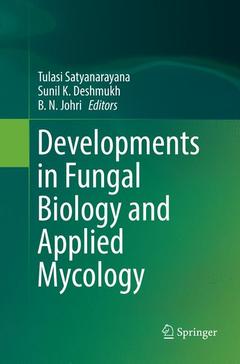Developments in Fungal Biology and Applied Mycology, 1st ed. 2017
Coordonnateurs : Satyanarayana Tulasi, Deshmukh Sunil K., Johri B.N.

This book explores the developments in important aspects of fungi related to the environment, industrial mycology, microbiology, biotechnology, and agriculture. It discusses at length both basic and applied aspects of fungi and provides up-to-date laboratory-based data.
Of the estimated three million species of fungi on Earth, according to Hawksworth and coworkers, more than 100,000 have been described to date. Many fungi produce toxins, organic acids, antibiotics and other secondary metabolites, and are sources of useful biocatalysts such as cellulases, xylanases, proteases and pectinases, to mention a few. They can also cause diseases in animals as well as plants and many are able to break down complex organic molecules such as lignin and pollutants like xenobiotics, petroleum and polycyclic aromatic compounds. Current research on mushrooms focuses on their hypoglycemic, anti-cancer, anti-pathogenic and immunity-enhancing activities.This ready-reference resource on various aspects of fungi is intended for graduate and post-graduate students as well as researchers in life sciences, microbiology, botany, environmental sciences and biotechnology.
Prof. T. Satyanarayana became a faculty fellow at the Division of Biological Sciences & Engineering, Netaji Subhas Institute of Technology (affiliated to the University of Delhi), New Delhi after retiring from Department of Microbiology, University of Delhi South Campus, New Delhi in 2016. He has over 270 scientific papers and reviews, 6 edited books and 3 patents to his credit. He is a fellow of National Academy of Agricultural Sciences (NAAS), the Association of Microbiologists of India (AMI), the Biotech Research Society (I) and the Mycological Society of India (MSI). He has 40 years of research and teaching experience and was president of the AMI and MSI. His research has focused on understanding the diversity and applications of yeasts, thermophilic fungi and bacteria and their enzymes as well as carbon sequestration using extremophilic bacterial carbonic anhydrases.
Dr. Bhavdish N Johri is a professor and NASI senior scientist at the Department of Biotechnology & Bioinformatics Centre, Barkatullah University, India. He has been the recipient of many academic awards, including the Indian National Science Academy’s Young Scientist Medal, Rafi Kidwai Memorial award and Acharya PC Ray Fellowship (MPCST). He is a fellow of the National Academy of Sciences (I), National Academy of Agricultural Sciences and National Institute of Ecology. He has extensive teaching and research experience, and has 148 research publications and 3 edited books to his credit.
Dr. Sunil Kumar Deshmukh is a fellow and area convenor at the Nano-Biotechnology Research Centre, The Energy and Resources Institute (TERI), New Delhi. He was assistant director (Natural Products) at Piramal Enterprises Ltd., Mumbai. He has broad industrial experience in the field of applied microbiology. He is now president of the Mycological Society of India. He has 100 publications and eight patent to his credit. He has also edited seven books.
Date de parution : 12-2018
Ouvrage de 605 p.
15.5x23.5 cm
Disponible chez l'éditeur (délai d'approvisionnement : 15 jours).
Prix indicatif 316,49 €
Ajouter au panierDate de parution : 01-2018
Ouvrage de 605 p.
15.5x23.5 cm
Thèmes de Developments in Fungal Biology and Applied Mycology :
Mots-clés :
fungi; yeast; endophytes; mycorrhizae; mycoremediation; probiotic yeast; mycology



